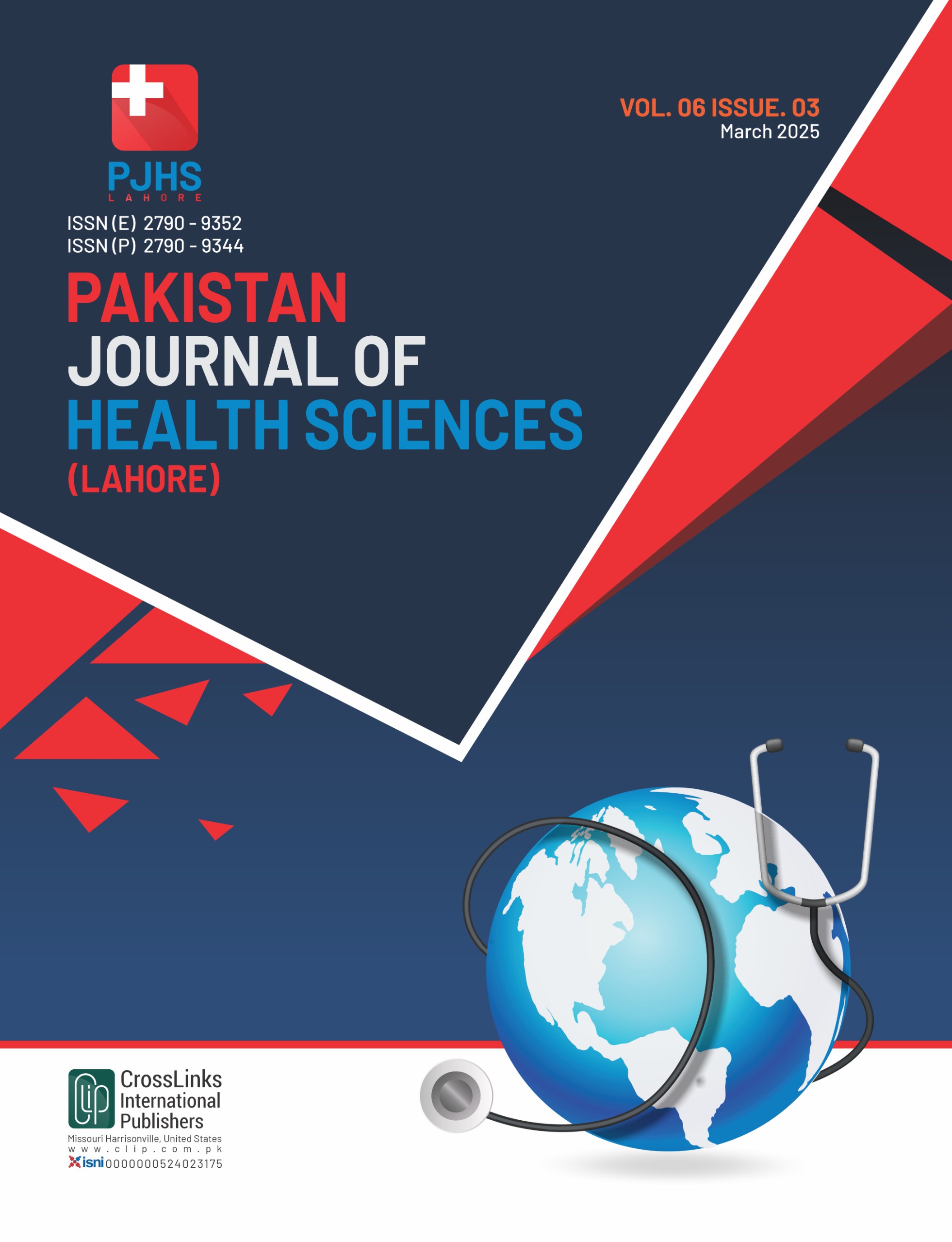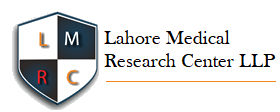Polycystic Ovary Syndrome (PCOS): A Biochemical and Physiological Perspective on a Common Gynaecological Disorder in a Local Hospital of Peshawar
PCOS: Biochemical and Physiological Perspective on a Gynaecological Disorder
DOI:
https://doi.org/10.54393/pjhs.v6i3.2920Keywords:
Polycystic Ovary Syndrome, Hormonal Imbalance, Insulin Resistance, Oxidative StressAbstract
Polycystic ovary syndrome (PCOS) is a common endocrine disorder affecting reproductive and metabolic health. It is characterized by hormonal imbalances, insulin resistance, dyslipidemia, and chronic inflammation, increasing long-term health risks. Objective: To compare biochemical, metabolic, and ultrasound markers in women with and without PCOS. Methods: A comparative cross-sectional study was conducted at Health Net Hospital, Peshawar, over six months. In total, 110 participants were recruited and divided equally into 2 groups, with each group considered as PCOS (n=55) and Non-PCOS (n=55). PCOS was diagnosed using the Rotterdam Criteria. Hormonal, metabolic, and inflammatory markers, including luteinizing hormone, Follicle-Stimulating Hormone, testosterone, Dehydroepiandrosterone Sulphate, Anti-Müllerian Hormone, fasting glucose, Homeostasis Model Assessment of Insulin Resistance (HOMA-IR), lipid profile, C-reactive protein, Malondialdehyde, and Total Antioxidant Capacity (TAC), were analyzed. Ultrasound findings assessed ovarian morphology, endometrial thickness, and stromal resistance index. Data were analyzed using SPSS. Results: PCOS patients had significantly higher BMI, insulin resistance, and androgen levels. Luteinizing hormone/Follicle-Stimulating Hormone ratio and Anti-Müllerian Hormone were elevated, while Follicle-Stimulating Hormone was lower. Metabolic markers showed increased fasting glucose, HOMA-IR, and dyslipidaemia, with higher LDL and triglycerides and lower HDL. Inflammatory and oxidative stress markers (C-reactive protein, Malondialdehyde) were significantly elevated, while TAC was reduced. Ultrasound findings showed increased endometrial thickness and ovarian stromal resistance in PCOS. Conclusions: It was concluded that PCOS is associated with significant hormonal, metabolic, and inflammatory disturbances. Elevated androgens, insulin resistance, and oxidative stress highlight the need for early screening and a multidisciplinary approach for Effective Management.
References
Joham AE, Norman RJ, Stener-Victorin E, Legro RS, Franks S, Moran LJ et al. Polycystic Ovary Syndrome. The lancet Diabetes and endocrinology. 2022 Sep; 10(9): 668-80. doi: 10.1016/S2213-8587(22)00163-2. DOI: https://doi.org/10.1016/S2213-8587(22)00163-2
Liu J, Wu Q, Hao Y, Jiao M, Wang X, Jiang S et al. Measuring the Global Disease Burden of Polycystic Ovary Syndrome in 194 Countries: Global Burden of Disease Study 2017. Human Reproduction. 2021 Apr; 36(4): 1108-19. doi: 10.1093/humrep/deaa371. DOI: https://doi.org/10.1093/humrep/deaa371
Skiba MA, Bell RJ, Herbert D, Garcia AM, Islam RM, Davis SR. Use of Community-Based Reference Ranges to Estimate the Prevalence of Polycystic Ovary Syndrome by the Recognised Diagnostic Criteria, A Cross-Sectional Study. Human Reproduction. 2021 Jun; 36(6): 1611-20. doi: 10.1093/humrep/deab069. DOI: https://doi.org/10.1093/humrep/deab069
Pea J, Bryan J, Wan C, Oldfield AL, Ganga K, Carter FE et al. Ultra-sonographic Criteria in the Diagnosis of Polycystic Ovary Syndrome: A Systematic Review and Diagnostic Meta-Analysis. Human Reproduction Update. 2024 Jan; 30(1): 109-30. doi: 10.1093/humupd/dmad027. DOI: https://doi.org/10.1093/humupd/dmad027
Chang KJ, Chen JH, Chen KH. The Pathophysiological Mechanism and Clinical Treatment of Polycystic Ovary Syndrome: A Molecular and Cellular Review of the Literature. International Journal of Molecular Sciences. 2024 Aug; 25(16): 9037. doi: 10.3390/ijms25169037. DOI: https://doi.org/10.3390/ijms25169037
Armanini D, Boscaro M, Bordin L, Sabbadin C. Controversies in the Pathogenesis, Diagnosis and Treatment of PCOS: Focus On Insulin Resistance, Inflammation, and Hyperandrogenism. International Journal of Molecular Sciences. 2022 Apr; 23(8): 4110. doi: 10.3390/ijms23084110. DOI: https://doi.org/10.3390/ijms23084110
Liao B, Qiao J, Pang Y. Central Regulation of PCOS: Abnormal Neuronal-Reproductive-Metabolic Circuits in PCOS Pathophysiology. Frontiers in Endocrinology. 2021 May; 12: 667422. doi: 10.3389/fendo.2021.667422. DOI: https://doi.org/10.3389/fendo.2021.667422
Parker J. PCOS and Insulin Resistance: Metabolic Dysregulation of an Ancient Adaptive Survival Mechanism. Journal of the Australasian College of Nutritional and Environmental Medicine. 2023 Sep; 42(3): 30-9.
Di Michele S, Fulghesu AM, Pittui E, Cordella M, Sicilia G, Mandurino G et al. Ultrasound Assessment in Polycystic Ovary Syndrome Diagnosis: From Origins to Future Perspectives—A Comprehensive Review. Biomedicines. 2025 Feb; 13(2): 453. doi: 10.3390/biomedicines13020453. DOI: https://doi.org/10.3390/biomedicines13020453
Bozkurt M, Kara Bozkurt D, Kurban D, Takmaz T, Sevket O, Ozcan P. 2-D and 3-D Ultrasonographic Characteristics of the Ovary in Women with PCOS and Multifollicular Ovaries. Journal of Obstetrics and Gynaecology. 2021 Aug; 41(6): 920-6. doi: 10.1080/01443615.2020.1803244. DOI: https://doi.org/10.1080/01443615.2020.1803244
Guleken Z, Bulut H, Bulut B, Depciuch J. Assessment of the Effect of Endocrine Abnormalities On Biomacromolecules and Lipids by FT-IR and Biochemical Assays as Biomarker of Metabolites in Early Polycystic Ovary Syndrome Women. Journal of Pharmaceutical and Biomedical Analysis. 2021 Sep; 204: 114250. doi: 10.1016/j.jpba.2021.114250. DOI: https://doi.org/10.1016/j.jpba.2021.114250
Younesi L, Lima ZS, Sene AA, Jebelli ZH, Amjad G. Comparison of Uterine and Ovarian Stromal Blood Flow in Patients with Polycystic Ovarian Syndrome. Endocrine Connections. 2019 Jan; 8(1): 50-6. doi: 10.1530/EC-18-0423. DOI: https://doi.org/10.1530/EC-18-0423
Yang J and Chen C. Hormonal Changes in PCOS. Journal of Endocrinology. 2024 Apr; 261(1). doi: 10.1530/JOE-23-0342. DOI: https://doi.org/10.1530/JOE-23-0342
Maheshwari N, Hassan T, Rashid G. PCOS and the Rhythmicity of GnRH: The Impact of FSH and LH on Menstrual Health. Obstetrics and Gynaecology Advances. 2023; 27.
Alhassan S, Elmugadam A, Elfadil GA, Abubaker N, Elfaki EM, Hamza A et al. Diagnostic Performance of Anti-Müllerian Hormone, Luteinizing Hormone to Follicle-Stimulating Hormone Ratio, Testosterone, and Prolactin to Predict Polycystic Ovary Syndrome Among Sudanese Women. International Journal of Women's Health. 2023 Dec: 837-43. doi: 10.2147/IJWH.S403347. DOI: https://doi.org/10.2147/IJWH.S403347
Guo Z, Jin F, Chen S, Hu P, Hao Y, Yu Q. Correlation between biochemical and clinical hyperandrogenism parameters in polycystic ovary syndrome by age. BioMed Central Endocrine Disorders. 2023 Apr; 23(1): 89. doi: 10.1186/s12902-023-01346-x. DOI: https://doi.org/10.1186/s12902-023-01346-x
Ding H, Zhang J, Zhang F, Zhang S, Chen X, Liang W et al. Resistance to the Insulin and Elevated Level of Androgen: A Major Cause of Polycystic Ovary Syndrome. Frontiers in Endocrinology. 2021 Oct; 12: 741764. doi: 10.3389/fendo.2021.741764. DOI: https://doi.org/10.3389/fendo.2021.741764
Kanbour SA and Dobs AS. Hyperandrogenism in Women with Polycystic Ovarian Syndrome: Pathophysiology and Controversies. Androgens: Clinical Research and Therapeutics. 2022 Mar; 3(1): 22-30. doi: 10.1089/andro.2021.0020. DOI: https://doi.org/10.1089/andro.2021.0020
Zhao H, Zhang J, Cheng X, Nie X, He B. Insulin Resistance in Polycystic Ovary Syndrome Across Various Tissues: An Updated Review of Pathogenesis, Evaluation, and Treatment. Journal of Ovarian Research. 2023 Jan; 16(1): 9. doi: 10.1186/s13048-022-01091-0. DOI: https://doi.org/10.1186/s13048-022-01091-0
Tong C, Wu Y, Zhang L, Yu Y. Insulin Resistance, Autophagy and Apoptosis in Patients with Polycystic Ovary Syndrome: Association with PI3K Signalling Pathway. Frontiers in Endocrinology. 2022 Dec; 13: 1091147. doi: 10.3389/fendo.2022.1091147. DOI: https://doi.org/10.3389/fendo.2022.1091147
Mancini A, Bruno C, Vergani E, d’Abate C, Giacchi E, Silvestrini A. Oxidative Stress and Low-Grade Inflammation in Polycystic Ovary Syndrome: Controversies and New Insights. International Journal of Molecular Sciences. 2021 Feb; 22(4): 1667. doi: 10.3390/ijms22041667. DOI: https://doi.org/10.3390/ijms22041667
Rudnicka E, Suchta K, Grymowicz M, Calik-Ksepka A, Smolarczyk K, Duszewska AM et al. Chronic Low-Grade Inflammation in the Pathogenesis of PCOS. International Journal of Molecular Sciences. 2021 Apr; 22(7): 3789. doi: 10.3390/ijms22073789. DOI: https://doi.org/10.3390/ijms22073789
Rostamtabar M, Esmaeilzadeh S, Tourani M, Rahmani A, Baee M, Shirafkan F et al. Pathophysiological Roles of Chronic Low‐Grade Inflammation Mediators in Polycystic Ovary Syndrome. Journal of Cellular Physiology. 2021 Feb; 236(2): 824-38. doi: 10.1002/jcp.29912. DOI: https://doi.org/10.1002/jcp.29912
Gleicher N, Darmon S, Patrizio P, Barad DH. Reconsidering the Polycystic Ovary Syndrome (PCOS). Biomedicines. 2022 Jun; 10(7): 1505. doi: 10.3390/biomedicines10071505. DOI: https://doi.org/10.3390/biomedicines10071505
Haddad-Filho H, Tosatti JA, Vale FM, Gomes KB, Reis FM. Updates in Diagnosing Polycystic Ovary Syndrome-Related Infertility. Expert Review of Molecular Diagnostics. 2023 Feb; 23(2): 123-32. doi: 10.1080/14737159.2023.2177536. DOI: https://doi.org/10.1080/14737159.2023.2177536
Conlon JL, Malcolm S, Monaghan M. Diagnosis and Treatment of Polycystic Ovary Syndrome in Adolescents. Journal of the American Academy of PAs. 2021 Oct; 34(10): 15-22. doi: 10.1097/01.JAA.0000791468.37054.5d. DOI: https://doi.org/10.1097/01.JAA.0000791468.37054.5d
Downloads
Published
How to Cite
Issue
Section
License
Copyright (c) 2025 Pakistan Journal of Health Sciences

This work is licensed under a Creative Commons Attribution 4.0 International License.
This is an open-access journal and all the published articles / items are distributed under the terms of the Creative Commons Attribution License, which permits unrestricted use, distribution, and reproduction in any medium, provided the original author and source are credited. For comments













